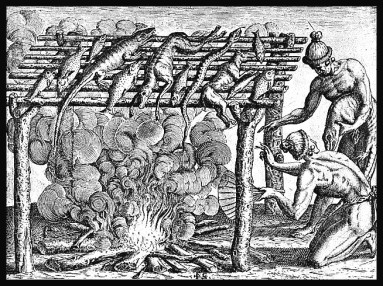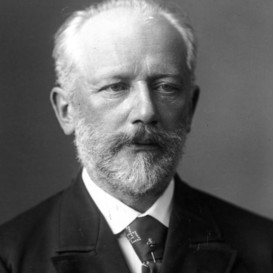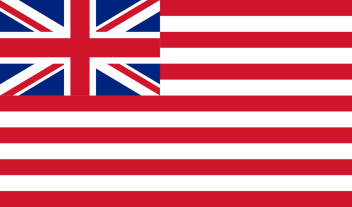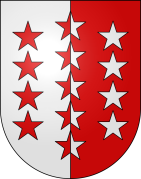The Fourth of July is the most American of all American holidays. It represents a declaration from tyranny and signaled the birth of this nation through fire and blood. But the items and music that we use to celebrate this auspicious event are decidedly foreign. The irony that the most Nationalist holiday we have is punctuated by globalist leanings has always struck me as rather funny. What’s even funnier is that the nationalists in this country are otherwise ignorant of the origins of these traditions.
I want you to think, for just a minute or two, what is typically included in a Fourth of July event: Barbecue, Hot Dogs, Hamburgers, Fireworks, Tchaikovsky’s 1812 Overture, and (of course) the  American Flag. All of these symbols have their roots elsewhere.
American Flag. All of these symbols have their roots elsewhere.
Barbecue, as a cooking method, has its roots in the Caribbean and many of the spices used in cooking barbecue have their origins in Central America, West Africa, and India. The term barbecue didn’t enter English lexicon until the 17th Century when Edmund Hickeringill used it to describe how Jamaicans cooked their food.  The term, however, originates from an Arawak word spelled barabicu which was adapted by the Spanish explorers into Barbacoa which eventually became the English word Barbecue. The Smithsonian also documents an instance in which the Conquistador Hernando de Soto attended a barbecue hosted by a Chickasaw tribe in present-day Mississippi in the year 1540.
The term, however, originates from an Arawak word spelled barabicu which was adapted by the Spanish explorers into Barbacoa which eventually became the English word Barbecue. The Smithsonian also documents an instance in which the Conquistador Hernando de Soto attended a barbecue hosted by a Chickasaw tribe in present-day Mississippi in the year 1540.
But what about the delicious foods we consume? Surely those are American, right? The cooking of beef and pork have obviously been taking place for thousands of years. But the specific types of pork and beef that we eat on the fourth are considered to be uniquely American variations of these foods. Hot Dogs and Hamburgers were first sold in the United States, this is true. However, they have their roots elsewhere. The humble hot dog is also known as wiener or wienie (pronounced WEE-ner and WEE-nee). These names also reveal the dish’s true origins – Austria and Germany. The word wiener (pronounced VEE-ner) in German means “of Vienna.” It’s a demonym for objects or people originating in Vienna, whose name in German is Wien. The other name for the little sausages is frankfurters. That name means, you guessed it, “of Frankfurt.” Although Austrians typically get credited for this little sausage, it was actually brought to Vienna by a man from Frankfurt named Johann Lahner. Thus, in Vienna, the dish is referred to as Frankfurter Wurstchen or Frankfurt Sausage. This sausage was introduced in America by a German immigrant named Charles Feltman who was a baker by trade. He placed the sausages in bread so they could be easily carried around by people by the beach at Coney Island.

Now, just as the term wiener betrays the European origins of the hot dog, so too does the word hamburger. The slight German lesson I gave you above should give you all of the contextual clues you need: hamburger means “of Hamburg,” another German city. Nobody can quite agree who first sold the hamburger but all agree that it was first sold in the United States and it was based on a German dish. No one can quite decide which German dish, however. The two main choices are variations of the same thing: The Hamburg Steak and Hamburger Rundstück. The Hamburg Steak exists in this country as Salisbury Steak, a name which it was given to avoid anti-German sentiment during World War I. The dish is quite simple – it’s chopped beef steak formed into a patty that is covered with brown gravy. Hamburger Rundstück is the same patty of chopped beef steak with brown gravy, but it is served on a warm roll so one can eat it with their hands. The traditional American Hamburger isn’t sold with the brown gravy of its German ancestors and is served instead as a sandwich with cheese and other condiments. The sandwich, of course, is named after the British Lord John Montagu, the Earl of Sandwich, who developed a penchant for eating meat between bread slices so he could continue to gamble without dirtying his hands. Thus, these two American staples – the hot dog and the hamburger – have their origins in Europe.
Next on the docket are fireworks. You could forgive most Americans for thinking they created fireworks because America seems the type to have a celebration marked by exploding gunpowder. However, fireworks, like gunpowder, have their origins in China. The earliest known mention of Fireworks was during the Tang Dynasty in the 7th Century. Throughout Chinese history, they have been used not only in religious practices but also in events like Chinese New Year celebrations. Fireworks made their way to Europe by way of traders and came to be used in celebration of formal events. The Pope sponsored what would be an annual fireworks display at the Castel Sant’Angelo in Rome to celebrate the Feast of St. Peter in 1471. There were fireworks present at Anne Boleyn’s coronation in 1533. They began to take hold in Europe with the rise of a form of art known as Chinoiserie which saw Continental Artisans attempt to imitate Asian art styles. Asian trade further blossomed in the 17th and 18th centuries which saw more Asian traditions come to Europe. European and Chinese immigrants alike brought an affinity for fireworks to the United States.
However, fireworks, like gunpowder, have their origins in China. The earliest known mention of Fireworks was during the Tang Dynasty in the 7th Century. Throughout Chinese history, they have been used not only in religious practices but also in events like Chinese New Year celebrations. Fireworks made their way to Europe by way of traders and came to be used in celebration of formal events. The Pope sponsored what would be an annual fireworks display at the Castel Sant’Angelo in Rome to celebrate the Feast of St. Peter in 1471. There were fireworks present at Anne Boleyn’s coronation in 1533. They began to take hold in Europe with the rise of a form of art known as Chinoiserie which saw Continental Artisans attempt to imitate Asian art styles. Asian trade further blossomed in the 17th and 18th centuries which saw more Asian traditions come to Europe. European and Chinese immigrants alike brought an affinity for fireworks to the United States.
Outside of The Star Spangled Banner, our national anthem, the song most associated with the Fourth of July is Pyotr Tchaikovsky’s 1812 Overture.

Pyotr Tchaikovsky
While most people realize that Tchaikovsky is obviously Russian, most people tend to believe that the “1812” in 1812 Overture refers to the same conflict that the Star Spangled Banner was born out of, the War of 1812. The War of 1812 is often glazed over in American history, aside from The Battle of Fort McHenry and Francis Scott Key, because it’s actually not a war that America won so much as it survived it. However, the end result was that the United States was officially recognized by the United Kingdom as being its own nation. That all sounds like the perfect inspiration for a symphonic masterpiece like the 1812 Overture but that conflict isn’t what inspired Tchaikovsky. What inspired Tchaikovsky was the Russian Empire’s defeat of Napoleon, which also happened in 1812. Following the victory, Tsar Alexander I commissioned a cathedral, The Cathedral of Christ the Savior in Moscow, to commemorate the occasion. The Tsar did not live to see it finished. It was finished during the reign of his grandson, Alexander II. It was the cathedral’s completion, and the event that it was dedicated to, that caused Tchaikovsky to write the piece. His friend suggested that he write it so that it could be used in the dedication ceremonies. So, how did a story of Russian victory become a paramount tune in the United States’ most important holiday? The Boston Pops. The Boston Pops first performed the Overture as part of their Fourth of July celebration in 1974 but it gained tremendous popularity during their televised performance of it during the 1976 Bicentennial celebration. The parts of the overture designed to simulate cannon fire, usually created with a sledgehammer, were instead created by synchronized firework displays. Thus was born an iconic American celebration.
Lastly, we have Old Glory herself – the American Flag. I know what you’re thinking, how is a flag created by Americans for America not rooted in America? Well, gather ’round, and let me tell you a tale. The usage of stars and stripes are not new in flag design. Stripes are very rudimentary geographic shapes and stars have been an important design implement essentially since humans could fathom the night sky. But the symbolism – surely that’s unique, right? Wrong.

The flag of the British East India Company
The thirteen red and white stripes were borrowed from the British East India Company, although it should be noted that EIC ensign varied in the number of stripes it possessed. The original Grand Union Flag was functionally identical to the EIC flag except it codified the number of stripes at 13 to represent the 13 colonies. The stars themselves were meant to also represent the 13 colonies but as a new constellation in the night sky. The stars on a blue field were at the time hitherto unique but their symbolism of disparate parts of one republic was not.

The Coat of Arms of Valais
The Canton of Valais in present day Switzerland has used stars to represent the number of districts within its borders since 1613 when it was first incorporated as a republic by the Bishop of Sion. As a bonus note to Old Glory, even the tune to which we sing The Star Spangled Banner is not American in origin. While it is well-known that My Country ‘Tis of Thee is sung to the tune of God Save the Queen, it isn’t widely known that the music for The Star Spangled Banner wasn’t composed specifically for it. The tune and music are taken from a song called To Anacreon in Heaven, an ode to the Anacreontic Society in London.
So, why did I take all the time to write all of this out? It’s simple. The Fourth of July celebrations in this country are, in effect, a metaphor for the United States. All of these traditions and symbolism came to these shores from around the world to create something. Our country is not one thing – it is many things that have come together. Our motto, E Pluribus Unum, means “out of many, one.” We have a proud tradition of taking foreign traditions and making them our own. Our country is a melting pot of cultures and ideas. Our current point in history is not the first time that we’ve tried to reject unfamiliar ideas from entering our amalgamated culture. It’s Islam now but it used to be Catholicism. It used to be the Irish. It used to be the Italians. As much as we have a proud history of taking in new cultures, we have a not-so-proud history of first attempting to reject them.
On this Fourth of July, I want everyone to remember what America is supposed to stand for. Remember that we are the Mother of Exiles. Remember that we are E Pluribus Unum. Remember the words of Langston Hughes:
America!
Land created in common,
Dream nourished in common,
Keep your hand on the plow! Hold on!
If the house is not yet finished,
Don’t be discouraged, builder!
If the fight is not yet won,
Don’t be weary, soldier!
The plan and the pattern is here,
Woven from the beginning
Into the warp and woof of America:
ALL MEN ARE CREATED EQUAL.
NO MAN IS GOOD ENOUGH
TO GOVERN ANOTHER MAN
WITHOUT HIS CONSENT.
BETTER TO DIE FREE,
THAN TO LIVE SLAVES.
Who said those things? Americans!
Who owns those words? America!
Who is America? You, me!
We are America!
To the enemy who would conquer us from without,
We say, NO!
To the enemy who would divide
And conquer us from within,
We say, NO!
FREEDOM!
BROTHERHOOD!
DEMOCRACY!
To all the enemies of these great words:
We say, NO!
America will be the shining city on the hill once more. We must only say “NO” to those opposed to that vision.
Happy 241st Birthday, America. You’ll survive this.